 VENUS
VENUS
Venus is the second planet from the sun in our solar system. It is the hottest planet in our Solar
System. This planet is covered with fast-moving sulphuric acid clouds which trap heat from the Sun. Its thick atmosphere is
mostly carbon dioxide. Venus has an iron core but only a very weak magnetic field. This is a planet on which a person would
asphyxiate in the poisonous atmosphere, be cooked in the extremely high heat, and be crushed by the enormous atmospheric pressure.
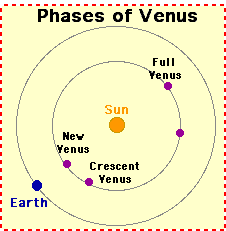 Venus is also known as the "morning star" or the "evening star" since it is visible and quite bright at either dawn
or dusk. It is only visible at dawn or dusk since it is closer to the sun than we are. Like the moon, Venus' appearance from
Earth changes as it orbits around the Sun. It goes from full to gibbous to crescent to new and back. Venus is about 7,521
miles (12,104 km) in diameter. This is about 95% of the diameter of the Earth. Venus is the closest to Earth in size and mass
of any of the other planets.
Venus is also known as the "morning star" or the "evening star" since it is visible and quite bright at either dawn
or dusk. It is only visible at dawn or dusk since it is closer to the sun than we are. Like the moon, Venus' appearance from
Earth changes as it orbits around the Sun. It goes from full to gibbous to crescent to new and back. Venus is about 7,521
miles (12,104 km) in diameter. This is about 95% of the diameter of the Earth. Venus is the closest to Earth in size and mass
of any of the other planets.
MASS AND GRAVITY
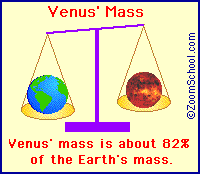 Venus' mass is about 4.87 x 1024 kg. The gravity on Venus is 91% of the gravity on Earth. A 100-pound person would
weigh 91 pounds on Venus. The density of Venus is 5,240 kg/m3, slightly less dense than the Earth and the third
densest planet in our Solar System (after the Earth and Mercury). Venus rotates VERY slowly. Each day on Venus takes 243 Earth
days. A year on Venus takes 224.7 Earth days. It takes 224.7 Earth days for Venus to orbit the sun once. The same side of
Venus always faces Earth when the Earth and Venus are closest together.
Venus' mass is about 4.87 x 1024 kg. The gravity on Venus is 91% of the gravity on Earth. A 100-pound person would
weigh 91 pounds on Venus. The density of Venus is 5,240 kg/m3, slightly less dense than the Earth and the third
densest planet in our Solar System (after the Earth and Mercury). Venus rotates VERY slowly. Each day on Venus takes 243 Earth
days. A year on Venus takes 224.7 Earth days. It takes 224.7 Earth days for Venus to orbit the sun once. The same side of
Venus always faces Earth when the Earth and Venus are closest together.
VENUS' ORBIT AND DISTANCE
FROM THE SUN
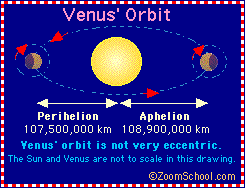 Venus is 67,230,000 miles (108,200,000 km) from the sun. Venus has an almost circular orbit. On average, Venus is 0.72 AU,
67,230,000 miles = 108,200,000 km from the sun.
Venus is 67,230,000 miles (108,200,000 km) from the sun. Venus has an almost circular orbit. On average, Venus is 0.72 AU,
67,230,000 miles = 108,200,000 km from the sun.
Venus rotates in the opposite direction of the and the other planets,
except possibly Looking from the north, Venus rotates clockwise, while the other planets rotate counterclockwise. From Venus,
the Sun would seem to rise in the west and set in the east (the opposite of Earth). No one knows why Venus has this unusual
rotation.
PLANETARY COMPOSITION
Venus has a rocky crust, a thick basaltic
rock mantle and a nickel-iron core. There is no surface water. The surface of Venus has been mapped through its cloud layer
using radar. The surface of Venus is covered with roughly 20 percent lowland plains of solidified lava, 70 percent rolling
uplands, and 10 percent highlands (volcanos, craters, mountains). The two major plains are called Aphrodite Terra Highlands
(about half the size of Africa) and Ishtar Terra (a lava-filled basin which is bigger than the United States). At the surface,
there are relatively slow winds.
Venus does not have a very strong magnetic field; this may be because of the planet's
slow rotation or perhaps Venus' core lacks a molten outer layer.
ATMOSPHERE AND CLOUD
Venus is covered by a thick layer of clouds.
These clouds are made mostly of sulfuric acid and are very fast moving, going up to 220 miles per hour (350 km per hour).
The clouds rotate 60 times faster than the planet rotates. The clouds circle Venus in four Earth days; the planet rotates
around its axis in 243 Earth days. These quickly-moving clouds distribute the heat around the planet, making the night side
hot also. V-shaped cloud patterns are visible in the middle latitudes when the clouds are examined in ultraviolet light.
The
clouds rain sulphuric acid (extremely acid rain), but this corrosive precipitation does not reach the surface. The high heat
beneath the clouds (up to 220°C) evaporates the rain drops about 10 miles (30 km) above Venus. Venus' atmosphere is mostly
gaseous carbon dioxide (96%). The remaining components are: 3% nitrogen and 0.003% water vapor. Venus may have had a lot of
water sometime in the past, but it probably boiled away in Venus' high temperatures.
The atmospheric pressure on Venus
is enormous, about 90 times greater than the atmospheric pressure on the Earth's surface. The greenhouse effect traps heat
in the atmosphere. The thick carbon dioxide atmosphere lets very little infrared radiation escape into space; most is reflected
back to the planet. Venus is the hottest planet in our Solar System. Its cloud cover traps the heat of the sun (the greenhouse
effect), giving Venus temperatures up to 480°C. The mean temperature on Venus is 726 K (452°C = 870°F).
FIRST SPACECRAFT TO REACH VENUS
Venera 3 (from the U.S.S.R.) was the first
manmade object to reach Venus. This Soviet spacecraft was launched on November 16, 1965. On March 1, 1966 , the spacecraft
arrived at Venus and the capsule parachuted down to the planet, but contact was lost just before entry into the atmosphere.
NAME AND SYMBOL
Venus was named after the Roman goddess
of love.
TRANSIT OF VENUS
During a transit of Venus, Venus passes
directly between the Earth and the Sun, and Venus appears as a small, dark dot crossing the bright disk of the Sun. Transits
of Venus are very rare - two transits of Venus occur every 125 years. Transits of Venus occur on June 8, 2004 and on June
6, 2012.  A transit is when a smaller body passes in front of a larger one (for example, when an object like Venus passes between the
Earth and the Sun). During a transit, the object (Venus in this case) appears
as a small, dark object crossing the larger object (the Sun in this case). A transit is just like a special type of solar
eclipse, but the Sun does not go dark; only a tiny bit of the Sun is obscured.
A transit is when a smaller body passes in front of a larger one (for example, when an object like Venus passes between the
Earth and the Sun). During a transit, the object (Venus in this case) appears
as a small, dark object crossing the larger object (the Sun in this case). A transit is just like a special type of solar
eclipse, but the Sun does not go dark; only a tiny bit of the Sun is obscured.
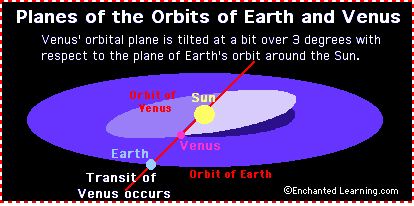
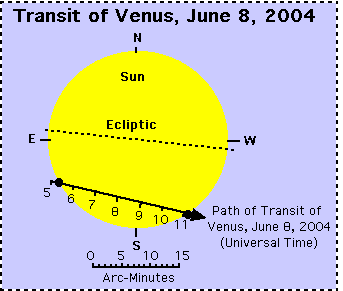
The June 2004 transit of Venus will last over 5 hours, starting at 5:13 Universal Time (UT) and ending at 11:25 UT. |
How long does a transit of Venus last?
 A transit of Venus lasts from 3 to 7 hours; the exact time depends on the path taken across the Sun. The June 2004 and June
2012 transits of Venus will each last over 5 hours.
A transit of Venus lasts from 3 to 7 hours; the exact time depends on the path taken across the Sun. The June 2004 and June
2012 transits of Venus will each last over 5 hours.
The black drop effect
At the beginning of a transit of Venus, when Venus
has just entered the Sun's disk, an odd optical phenomenon occurs; it is called the black drop effect. The light from the
Sun is bent around Venus (it is refracted by Venus' dense atmosphere), making Venus look stretched-out. This phenomenon also
occurs towards the end of a transit of Venus, just before Venus leaves the solar disk.
How often does a transit of Venus occur?
A transit of Venus is very rare. On average, there are two transits of Venus
every 125 years. Only five transits of Venus have been seen by human beings. Before the transit of Venus in June 2004, previously
observed ones happened on December 4, 1639, June 5, 1761, June 3, 1769, December 8, 1874, and December 6, 1882. There have
been only 52 transits of Venus across the Sun between 2000 B.C and A.D.1882.
What can a transit
of Venus tell us?
In 1716, Edmund Halley published a paper describing how a planetary transit (a
transit of Venus or Mercury) could be used to measure our distance from the Sun, called, "A new Method of determining the
Parallax of the Sun." Expeditions were sent out in 1761 and 1769 to observe transits of Venus (to estimate the Earth's distance
from the Sun).
James Cook (October 27, 1728 - February 14, 1779) was a British explorer
and astronomer who sailed to Tahiti in 1769 on the H.M.S. Endeavor in order to observe a transit of Venus; he was also searching
for a large, southern continent that was thought to exist (but does not). After sailing for 8 months, he stayed in Tahiti
for many months preparing for the transit. Astronomers later combined his data with those of other widely-separated observers
to estimate the distance from the Earth to the Sun (1 astronomical unit).
| Mission Name |
Date |
Accomplishment |
| Mariner 2 |
1962 |
Fly-by mission |
| Venera 7 |
1970 |
First landing on another planet |
| Mariner 10 |
1974 |
First close-up photos |
| Venera 9 |
1975 |
First photos of the surface |
| Pioneer Venus 1 |
1978 |
First radar, UV, and infrared images |
| Pioneer Venus 2 |
1978 |
Probe examines the atmosphere |
| Magellan |
1990 |
Global radar mapping (through the clouds) |
Venus has been visited by spacecraft over 20 times. It was visited
by NASA'sMariner 2 (in 1962), Pioneer Venus (in 1978), the Soviet Union's Venera 7 (in
1970) and Venera 9 (in 1975, this was the first spacecraft to land on another planet).
FILL IN THE BLANKS:
Venus is the __________________________ planet from
the Sun in our Solar System. It is the _________________________ planet in our Solar System. This planet is covered with fast-moving
sulphuric acid clouds which trap __________________________ from the Sun. Its thick atmosphere is mostly carbon dioxide. Its
__________________________ cover traps the heat of the sun (the greenhouse effect), giving Venus temperatures up to 480°C.
Venus is a planet on which a person would asphyxiate in the poisonous __________________________, be cooked in the extremely
high heat, and be __________________________ by the enormous atmospheric pressure. Venus was named after the Roman goddess
of love.
Venus has an ________________________ core but only
a very weak magnetic __________________________. It has no moons. Venus is about 7,521 miles (12,104 km) in diameter; this
is about 95% of the diameter of the Earth. Venus is the closest to Earth in size and mass of any of the other planets in our
Solar System. Venus' __________________________ is about 4.87 x 1024 kg. The gravity on Venus is 91% of the __________________________
on Earth. A 100-pound person would weigh 91 pounds on Venus.
Venus is also known as the "__________________________
star" or the "evening star" since it is visible and quite bright at either dawn or dusk. It is only __________________________
at dawn or __________________________ since it is closer to the __________________________ than we are. Like the moon, Venus'
appearance from Earth changes as it orbits around the Sun. It goes from full to gibbous to __________________________ to new
and back.
ANSWERS:
Venus is the second planet from
the Sun in our Solar System. It is the hottest planet in our Solar System. This planet is covered with fast-moving
sulphuric acid clouds which trap heat from the Sun. Its thick atmosphere is mostly carbon dioxide. Its cloud
cover traps the heat of the sun (the greenhouse effect), giving Venus temperatures up to 480°C. Venus is a planet on which
a person would asphyxiate in the poisonous atmosphere, be cooked in the extremely high heat, and be crushed
by the enormous atmospheric pressure. Venus was named after the Roman goddess of love.
Venus has an iron core but only a very weak magnetic field. It has no moons. Venus is about 7,521 miles (12,104
km) in diameter; this is about 95% of the diameter of the Earth. Venus is the closest to Earth in size and mass of any of
the other planets in our Solar System. Venus' mass is about 4.87 x 1024 kg. The gravity on Venus is 91%
of the gravity on Earth. A 100-pound person would weigh 91 pounds on Venus.
Venus is also known as the "morning star" or the "evening star" since it is visible and quite bright at either dawn
or dusk. It is only visible at dawn or dusk since it is closer to the Sun than we are. Like the moon,
Venus' appearance from Earth changes as it orbits around the Sun. It goes from full to gibbous to crescent to new and
back.

